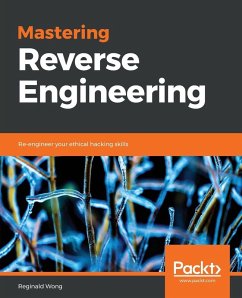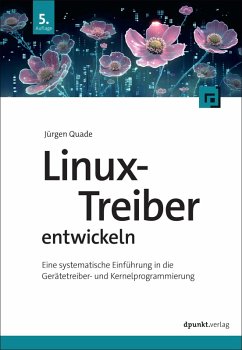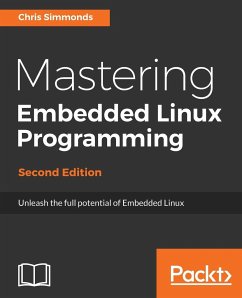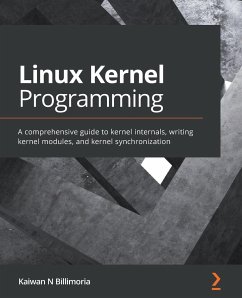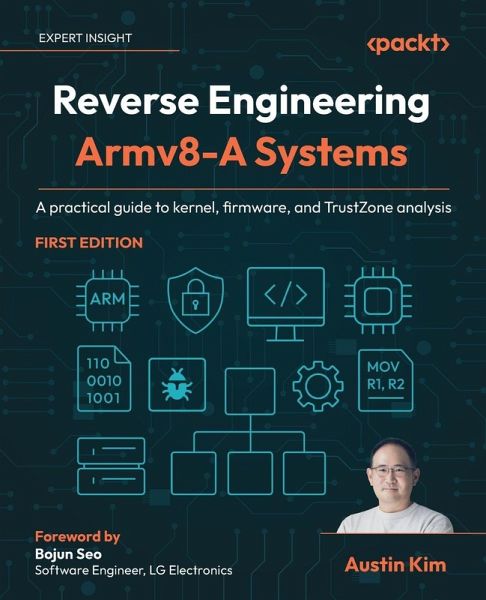
Reverse Engineering Armv8-A Systems
A practical guide to kernel, firmware, and TrustZone analysis

PAYBACK Punkte
26 °P sammeln!
Explore reverse engineering in Armv8-A-based Arm devices, develop the skills to analyze binaries, and leverage cutting-edge security hardening features through hands-on techniques and expert insights Key Features: - Master key aspects of Armv8-A, including register, exception handling, and TrustZone - Build new reversing skills for kernel binaries, such as *.ko and vmlinux, for firmware analysis - Understand Armv8-A's latest security features - Purchase of the print or Kindle book includes a free PDF eBook Book Description: Unlock the secrets hidden in binary code without needing the source! W...
Explore reverse engineering in Armv8-A-based Arm devices, develop the skills to analyze binaries, and leverage cutting-edge security hardening features through hands-on techniques and expert insights Key Features: - Master key aspects of Armv8-A, including register, exception handling, and TrustZone - Build new reversing skills for kernel binaries, such as *.ko and vmlinux, for firmware analysis - Understand Armv8-A's latest security features - Purchase of the print or Kindle book includes a free PDF eBook Book Description: Unlock the secrets hidden in binary code without needing the source! Written by a Linux kernel engineer and author with over 14 years of industry experience, this book lays a solid foundation in reverse engineering and takes you from curious analyst to expert. You'll master advanced techniques to dissect kernel binaries, including kernel module files, vmlinux, and vmcore, giving you the power to analyze systems at their core. This practical, three-part journey starts with the essentials of reverse engineering, introducing the key features of Armv8-A processors and the ELF file format. The second part walks you through the reverse-engineering process, from Arm environment setup to using static and dynamic analysis tools, including innovative methods for analyzing kernel binaries and the powerful debugging tool uftrace. The final part covers security, exploring TrustZone and the latest security techniques to safeguard Arm devices at the hardware level. By the end of this reverse engineering book, you'll have comprehensive Armv8-A expertise and the practical skills to analyze any binary with confidence while leveraging advanced security features to harden your systems. What You Will Learn: - Understand the organization of Arm assembly instructions - Disassemble assembly code without using C code - Work with reverse engineering tools, such as GDB and binary utility - Apply reversing techniques for both user space and kernel binaries - Get to grips with static and dynamic binary analysis processes - Get a solid understanding of the powerful debugging tool, uftrace - Analyze TrustZone and the advanced security features provided by Armv8-A Who this book is for: This book is for professionals and enthusiasts interested in reverse engineering and debugging on Armv8-A-based devices. It is especially useful for system software engineers, security consultants, and ethical hackers expanding their binary analysis expertise. To get the most out of this book, you should have a basic understanding of the C programming language. Familiarity with computer architecture, Linux systems, and security concepts will be a definite advantage. Table of Contents - Learning Fundamentals of Arm Architecture - Understanding the ELF Binary Format - Manipulating Data with Arm Data Processing Instructions - Reading and Writing with Memory Access Instructions - Controlling Execution with Flow Control Instructions - Introducing Reverse Engineering - Setting Up a Practice Environment with an Arm Device - Unpacking the Kernel with Linux Fundamentals - Understanding Basic Static Analysis - Going Deeper with Advanced Static Analysis - Analyzing Program Behavior with Basic Dynamic Analysis - Expert Techniques in Advanced Dynamic Analysis - Tracing Execution with uftrace - Securing Execution with Armv8-A TrustZone - Building Defenses with Key Security Features of Armv8-A




